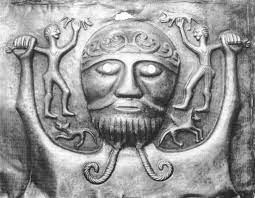

ORIGIN: Celtic [Irish]
TYPE: Father of the tribe
KNOWN PERIOD OF WORSHIP: From prehistoric times until after Christianization circa CE 400.
SYNONYMS: Ruad ro-fhessa (lord of perfect knowledge); Eochaid Ollathair (all-father)
CENTER(S) OF CULT: Tara, etc.
ART REFERENCES: Possibly various stone carvings, Romano-Celtic and earlier.
LITERARY SOURCES: Book of Invations; Cycles of Kings
ABODE: Bru na Boinne
WEAPONS: Club, mace
BATTLES: Magh Tuiredh
ARTEFACTS: Staff, Cauldron, Harp
PARENTS: Elatha, Ethniu
SIBLINGS: Ogma
CONSORTS: Morrigan, Boand
CHILDREN: Aed, Aengus, Bodb Dearg, Cermait, Midir, Brigit.
INFORMATION: The Dagda is strictly an Irish tribal god not found among the Continental Celts. He is regarded in a general sense as the protector and benefactor of the people, not "good" in a moral sense but in a practical fashion—"good at anything". A father figure who led the deities of Ireland against the Fir Bolg in the First Battle of Moytura (see Tuatha de Danann). He has no exclusive roles, but in mythology enters a ritualized union with fertility goddesses including Morrigan and Boann. He is the father of Brigit and Aengus Mac Oc (young god). Dagda is represented in literature as possessing immense strength and a prodigious appetite (see also Thor). Drawn by Christian writers as boorish and grotesque character, which may be inaccurate, his weapon is a huge club which can slay nine men at a stroke and which was once drawn on a ceremonial cart. He owns a bronze "cauldron of abundance" with magical properties of wisdom and rejuvenation, symbol of Irish prosperity. The Dagda may be the subject of a vast naked figure armed with a club cut in chalk at Cerne Abbas in Dorset, England, and probably created during the Romano-Celtic period.